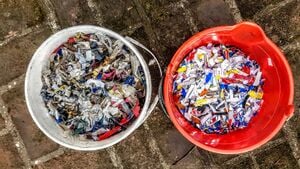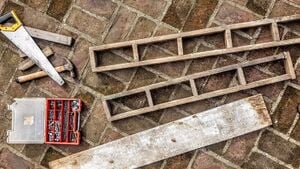 Finished eco-brick.
Finished eco-brick.This page explains how to produce homemade bricks from a mixture of cement and plastic.
I did this project in order to recycle my plastic trash myself. Although I try to reduce my plastic consumption more and more, something always remains. With this technique, I can transform that little bit into bricks and when I have many I will do something useful with them.
Making bricks is an excellent solution to the problem of excess plastic, because unlike other forms of recycling, it allows you to recycle huge quantities of plastic, of any type, without laborious prior separation and without it becoming garbage again for decades, even centuries. .
Contents
Materials
cut plastic

I mainly use semi-rigid plastic (bottles, trays, etc.) cut by hand with scissors. I tried a blender, but it didn't work. Maybe with a processor it will work, I didn't try. At first I also cut supermarket bags, but if the scissors are not very sharp they are very laborious and provide very little volume, so I stopped doing it. Furthermore, supermarket bags (in Buenos Aires at least) can be put into so-called "love bottles" that are then recycled to produce plastic wood, a solution in many ways very similar to eco-bricks.
Brick molds

I made my own molds with some old wood and nails.
Concrete
That is, the classic mixture of cement, sand and water, for which you also need a bucket and a shovel or something similar to mix.
Procedure
Mix three parts sand, one part cement and one part water in a bucket. Stir until the desired consistency is reached.
The amount of concrete to prepare will depend on the amount of bricks we want to produce and plastic we want to recycle. As an example, with 1500 ml of sand, 500 ml of cement and 500 ml of water (plus plastic) three bricks are produced.
It is important to prepare the concrete before adding the plastic or else integrating everything becomes much more work. It can be mixed with a garden shovel or mason's spoon. In the video I do it by hand but then someone told me that cement can be toxic, so I recommend using gloves, especially if you are going to make many bricks or very often.
Add two parts of plastic for each part of cement. Continuing with the previous example, to 1500 ml of sand, 500 ml of cement and 500 ml of water, 1000 ml of plastic would have to be added.
The exact proportion of plastic is delicate. Too much plastic produces ugly, brittle bricks, while too little is inefficient, since the point is to recycle as much plastic as possible. After several tests, I came to the conclusion that approximately two parts plastic to every part cement works well. However, the amount of plastic that enters the pot that we use as a measurement depends on the pressure we apply. The ideal would be to weigh the plastic to give an exact proportion, but I haven't done that experiment yet.
Pour the mixture into the mold and press well to fill the molds as best as possible. Again, by hand it is much easier. I recommend using gloves.
It is important that it dry in the shade because if we leave it in the sun, the bricks can break.
Adobe version
The steps above are the result of several tests and failed attempts. In this section I describe some of these tests and the lessons learned.
CONICET bricks
For this project I was inspired by research from CONICET (National Council for Scientific and Technical Research of Argentina) where they produced much more sophisticated eco-bricks. The CONICET bricks have several points in their favor:
- Each one is made up of 20-30 recycled plastic bottles, crushed and mixed with cement, which are left out of the ecosystem for decades, if not centuries.
- They meet all the technical and legal requirements to be used in constructions of up to two floors in Argentina.
- They achieve twice the thermal insulation of conventional bricks, so some projects can use half as many bricks and thus reduce costs.
- They are almost 40% lighter than conventional bricks, so you can also save on the foundations.
- Their production does not require laborious and expensive waste separation (bottle, cap and label are crushed together) or specialized labor, so they are a potential source of employment and massive recycling.
CONICET released the details of the research so that municipalities and entrepreneurs could replicate the technique and market it. Thus, in 2017 the municipality of Junín de Mendoza was already recycling more than 60% of its plastic using this technique (probably more today). Another adopter in Córdoba uses them to build social housing and even won a Google innovation award .
However, when I wanted to download the research to adapt it to my own purposes, it was no longer available. I wrote to them but they didn't respond, so I had to start from scratch.
See also
- LCA of cement - Life cycle and environmental impact of cement
